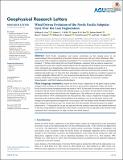Wind-driven evolution of the North Pacific subpolar gyre over the last deglaciation
Abstract
North Pacific atmospheric and oceanic circulations are key missing pieces in our understanding of the reorganisation of the global climate system since the Last Glacial Maximum (LGM). Here, using a basin‐wide compilation of planktic foraminiferal δ18O, we show that the North Pacific subpolar gyre extended ~3° further south during the LGM, consistent with sea surface temperature and productivity proxy data. Climate models indicate that the expansion of the subpolar gyre was associated with a substantial gyre strengthening, and that these gyre circulation changes were driven by a southward shift of the mid‐latitude westerlies and increased wind‐stress from the polar easterlies. Using single‐forcing model runs, we show that these atmospheric circulation changes are a non‐linear response to ice‐sheet topography/albedo, and CO2. Our reconstruction indicates that the gyre boundary (and thus westerly winds) began to migrate northward at ~16.5 ka, driving changes in ocean heat transport, biogeochemistry, and North American hydroclimate.
Citation
Gray , W R , Wills , R CJ , Rae , J W B , Burke , A , Ivanovic , R F , Roberts , W HG , Ferreira , D & Valdes , P J 2020 , ' Wind-driven evolution of the North Pacific subpolar gyre over the last deglaciation ' , Geophysical Research Letters , vol. 47 , no. 6 , e2019GL086328 . https://doi.org/10.1029/2019GL086328
Publication
Geophysical Research Letters
Status
Peer reviewed
ISSN
0094-8276Type
Journal article
Description
Funding: UK Natural Environment Research Council (NERC) grant NE/N011716/1 (JWBR and AB). Tamaki Foundation, NASA (Grant NNX17AH56G), and NSF (Grant AGS-1929775) (RCJW). NERC Independent Research Fellowship NE/K008536/1 (RFI).Collections
Items in the St Andrews Research Repository are protected by copyright, with all rights reserved, unless otherwise indicated.

